
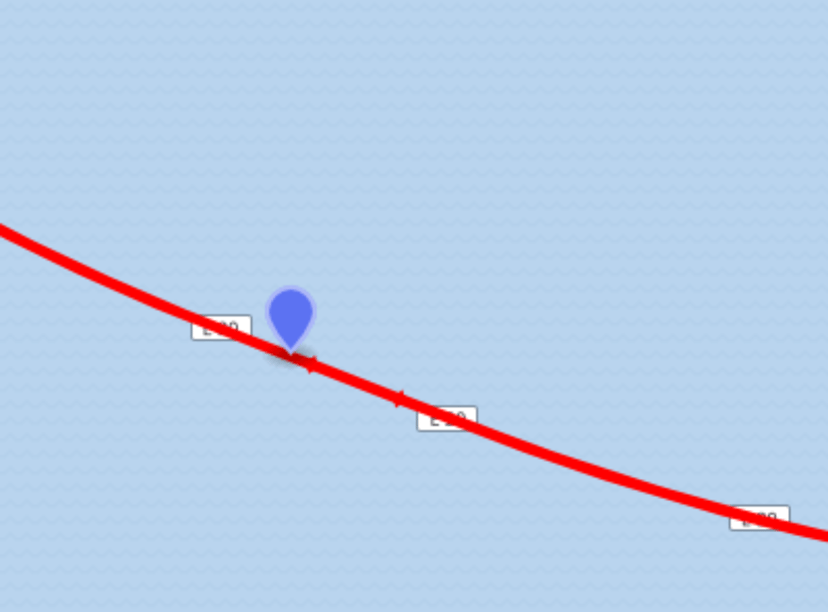
Øresund Bridge

|
Øresund Bridge
Öresund Bridge |
|
|---|---|
 |
|
| Coordinates | 55°34′31″N 12°49′37″E[39] |
| Carries | Four lanes of European route E20 Double-track Øresund Line |
| Crosses | Øresund strait (the Sound) |
| Locale | Copenhagen, Denmark andMalmö, Sweden |
| Official name | Øresundbron (used by company), Øresundsbroen, Öresundsbron |
| Characteristics | |
| Design | Cable-stayed bridge |
| Total length | 7,845 metres (25,738 ft) |
| Width | 23.5 metres (77.1 ft) |
| Height | 204 metres (669 ft) |
| Longest span | 490 metres (1,608 ft) |
| Clearance below | 57 metres (187 ft) |
| History | |
| Designer | Jorgen Nissen, Klaus Falbe Hansen, Niels Gimsing and Georg Rotne |
| Engineering design by | Ove Arup & Partners Setec ISC Gimsing & Madsen |
| Constructed by | Hochtief, Skanska, Højgaard & Schultz and Monberg & Thorsen |
| Construction start | 1995 |
| Construction end | 1999 |
| Construction cost | 19.6 billion DKK 25.8 billion SEK 2.6 billionEuro |
| Opened | 1 July 2000 |
| Statistics | |
| Daily traffic | ca. 19,000 road vehicles (2014)[1] |
| Toll | DKK 390, SEK 460 or€54 |
The Øresund or Öresund Bridge (Danish: Øresundsbroen [ˈøːɐsɔnsˌpʁoːˀn̩]; Swedish: Öresundsbron [œrɛ²sɵnːdsˌbruːn]; hybrid name: Øresundsbron) is a combined railway and motorway bridge spanning the Øresund strait between Sweden and Denmark. Extending nearly 8 kilometers (5 miles) from the Swedish coast to the artificial island of Peberholm in the middle of the strait, the bridge connects to the Danish island of Amager via the 4-kilometer (2.5 mi) Drogden Tunnel from Peberholm.
The Øresund Bridge holds the distinction of being the longest combined road and rail bridge in Europe, linking two prominent metropolitan areas: Copenhagen, the capital of Denmark, and the Swedish city of Malmö. It serves as a crucial link connecting the road and rail networks of the Scandinavian Peninsula with those of Central and Western Europe. Additionally, the bridge plays a pivotal role as the backbone of internet data transmission between central Europe and Sweden, and formerly Finland until 2016, through a dedicated data cable.[2]
The international European route E20 crosses via road, the Øresund Line via railway. The construction of the Great Belt Fixed Link (1988-1998), connecting Zealand to Funen and thence to the Jutland Peninsula, and the Øresund Bridge have connected Central and Western Europe to Scandinavia by road and rail.
The Øresund Bridge was designed by the Danish engineering firm COWI. The justification for the additional expenditure and complexity related to digging a tunnel for part of the way, rather than raising that section of the bridge, was to avoid interfering with air traffic from the nearby Copenhagen Airport, to provide a clear channel for ships in good weather or bad, and to prevent ice floes from blocking the strait.
The Øresund Bridge crosses the border between Denmark and Sweden. Although the Schengen Agreement and the Nordic Passport Union should mean no routine passport inspections, since January 2016, identity and visa checks have been imposed by Sweden on travellers from Denmark due to the European migrant crisis.[3]
Construction began in 1995, with the bridge opening to traffic on 1 July 2000. The Øresund Bridge received the 2002 IABSE Outstanding Structure Award.
|
Øresund Bridge
Öresund Bridge |
|
|---|---|
 |
|
| Coordinates | 55°34′31″N 12°49′37″E[39] |
| Carries | Four lanes of European route E20 Double-track Øresund Line |
| Crosses | Øresund strait (the Sound) |
| Locale | Copenhagen, Denmark andMalmö, Sweden |
| Official name | Øresundbron (used by company), Øresundsbroen, Öresundsbron |
| Characteristics | |
| Design | Cable-stayed bridge |
| Total length | 7,845 metres (25,738 ft) |
| Width | 23.5 metres (77.1 ft) |
| Height | 204 metres (669 ft) |
| Longest span | 490 metres (1,608 ft) |
| Clearance below | 57 metres (187 ft) |
| History | |
| Designer | Jorgen Nissen, Klaus Falbe Hansen, Niels Gimsing and Georg Rotne |
| Engineering design by | Ove Arup & Partners Setec ISC Gimsing & Madsen |
| Constructed by | Hochtief, Skanska, Højgaard & Schultz and Monberg & Thorsen |
| Construction start | 1995 |
| Construction end | 1999 |
| Construction cost | 19.6 billion DKK 25.8 billion SEK 2.6 billionEuro |
| Opened | 1 July 2000 |
| Statistics | |
| Daily traffic | ca. 19,000 road vehicles (2014)[1] |
| Toll | DKK 390, SEK 460 or€54 |
History
The idea of constructing a bridge over the Øresund was initially proposed in 1936 by a consortium of engineering firms as part of a plan for a national motorway network in Denmark. However, the concept was set aside during World War II. Subsequently, it resurfaced and underwent thorough examination by Danish-Swedish government commissions during the 1950s and 1960s. Debate ensued over the optimal location and design of the bridge, with some advocating for a link at the narrowest point of the sound between Helsingør and Helsingborg, north of Copenhagen, while others favored a more direct connection from Copenhagen to Malmö. Furthermore, regional and local interests contended that other bridge and road projects, notably the yet-to-be-built Great Belt Fixed Link, should take precedence. Despite these disagreements, Denmark and Sweden signed an agreement in 1973 to proceed with the construction of a fixed link. However, the project was shelved in 1978 due to economic challenges and mounting environmental apprehensions. With economic conditions improving in the 1980s, renewed interest in the project emerged, leading to the signing of a new agreement between the governments in 1991.[4][5]
An OMEGA centre report identified the following as primary motivations for construction of the bridge:[8]
-
to improve transport links in northern Europe, from Hamburg to Oslo;[8]
-
regional development around the Øresund as an answer to the intensifying globalisation process and Sweden’s decision to apply for membership of the European Community;[8]
-
connecting the two largest cities of the region, which were both experiencing economic difficulties;[8]
-
improving communications to Kastrup airport, the main flight transportation hub in the region.[8]
A consortium consisting of Hochtief, Skanska, Højgaard & Schultz, and Monberg & Thorsen, the same firms involved in the construction of the Great Belt Fixed Link, commenced work on the bridge in 1995 and successfully completed it on August 14, 1999. To commemorate the achievement, Crown Prince Frederik of Denmark and Crown Princess Victoria of Sweden met at the midpoint of the bridge-tunnel on August 14, 1999. The official dedication ceremony took place on July 1, 2000, with Queen Margrethe II and King Carl XVI Gustaf serving as hosts. However, due to a tragic incident at the Roskilde Festival the previous evening, during which nine individuals, including three Danes and three Swedes, lost their lives, the ceremony began with a minute of silence as a mark of respect. The bridge-tunnel was opened for public traffic later that day. On June 12, 2000, two weeks before the dedication ceremony, 79,871 runners participated in Broloppet, a half marathon from Amager, Denmark, to Skåne, Sweden, further highlighting the significance of the bridge’s completion.[13]
Despite two schedule setbacks – the discovery of 16 unexploded World War II bombs on the seafloor and an inadvertently skewed tunnel segment – the bridge-tunnel was finished three months ahead of schedule.
Although traffic between Denmark and Sweden increased by 61 percent in the first year after the bridge opened, traffic levels were not as high as expected, perhaps due to high tolls.[14]However, since 2005, traffic levels have increased rapidly. This may be due toDanesbuying homes in Sweden to take advantage of lower housing prices in Malmö and commuting to work in Denmark. In 2012, to cross by car cost DKK 310, SEK 375 or€43, with discounts of up to 75% available to regular users. In 2007, almost 25 million people travelled over the Øresund Bridge: 15.2 million by car and bus and 9.6 million by train. By 2009, the figure had risen to 35.6 million by car, coach or train.[15][16]
Link features
Bridge
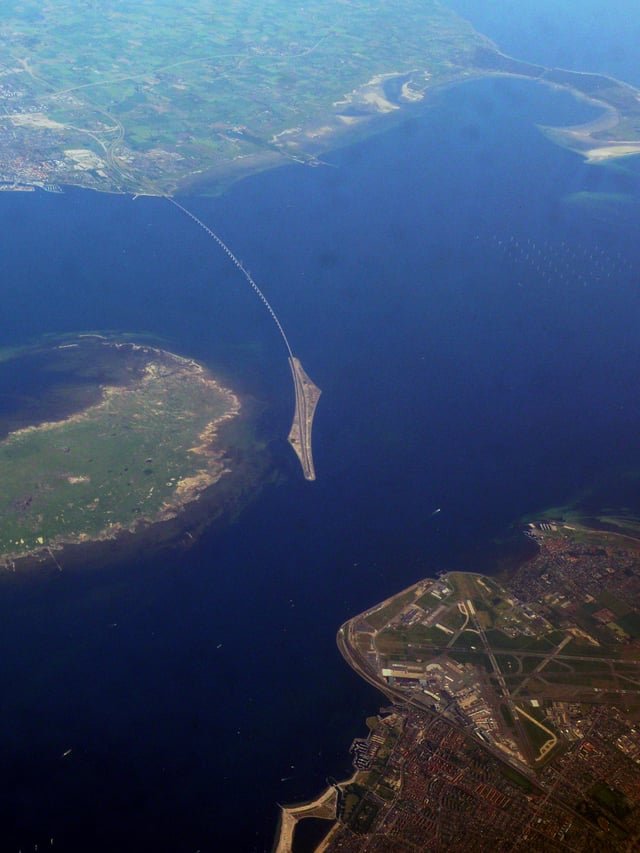
Aerial photo of Øresund Bridge. In the foreground is Copenhagen Airport on the island of Amager, to the left of the bridge is the Danish island of Saltholm, and in the background, the bridge connects to Malmö.
At 7,845 m (25,738 ft), the bridge covers half the distance between Sweden and the Danish island of Amager, the border between the two countries being 5.3 km (3.3 mi) from the Swedish end. The structure has a mass of 82,000 tonnes and supports two railway tracks beneath four road lanes in a horizontal girder extending along the entire length of the bridge. On both approaches to the three cable-stayed bridge sections, the girder is supported every 140 m (459 ft) by concrete piers. The two pairs of free-standing cable-supporting towers are 204 m (669 ft) high allowing shipping 57 m (187 ft) of head room under the main span, but most ships’ captains prefer to pass through the unobstructed Drogden Strait above the Drogden Tunnel. The cable-stayed main span is 491 m (1,611 ft) long. A girder and cable-stayed design was chosen to provide the specific rigidity necessary to carry heavy rail traffic, and also to resist large accumulations of ice. The bridge experiences occasional brief closures during very severe weather, such as the St. Jude storm of October 2013.[17]
Due to high longitudinal and transverse loads acting over the bridge and to accommodate movements between the superstructure and substructure, it has bearings weighing up to 20 t each, capable of bearing vertical loads up to 96,000 kN in a longitudinal direction and up to 40,000 kN in transverse direction. The design, manufacturing and installation of the bearings were carried out by the Swiss civil engineering firm Mageba.[18]
Vibration issues, caused by several cables in the bridge moving under certain wind and temperature conditions, were combatted with the installation of compression spring dampers installed in pairs at the centre of the cables. Two of these dampers were equipped with laser gauges for ongoing monitoring. ing, development and installation of these spring dampers was carried out by specialists European Springs.[19]
Peberholm
The bridge joins Drogden tunnel on the artificial island of Peberholm (Pepper Islet). The Danes chose the name to complement the natural island of Saltholm (Salt Islet) just to the north. Peberholm is a designated nature reserve built from Swedish rock and the soil dredged up during the bridge and tunnel construction, approximately 4 km (2.5 mi) long with an average width of 500 m (1,640 ft). It is 20 m (66 ft) high.
Drogden Tunnel
Cross-section of the Drogden Tunnel
The connection between Peberholm and the artificial peninsula at Kastrup on Amager island, which is the nearest populated part of Denmark, is facilitated by the Drogden Tunnel (Drogdentunnelen), measuring 4,050 meters (13,287 ft) in length. This tunnel consists of a 3,510-meter (11,516 ft) immersed tube, complemented by 270-meter (886 ft) entry tunnels at each end. Constructed from 20 prefabricated reinforced concrete segments, each weighing a staggering 55,000 tons, the tube tunnel is a marvel of engineering. These segments are interconnected within a trench excavated in the seabed. The tunnel comprises two tubes dedicated to railway tracks, two for roads, and a smaller fifth tube designated for emergency purposes. All tubes are arranged side-by-side to facilitate efficient transportation across the strait.
Rail transport
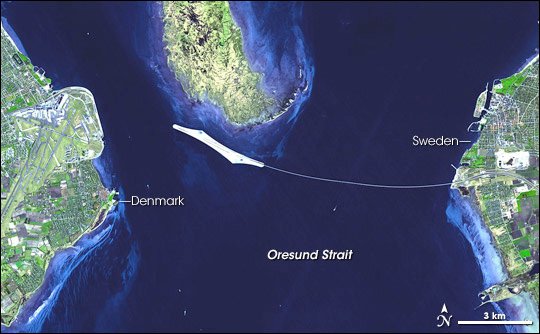
Satellite image of the Øresund Bridge
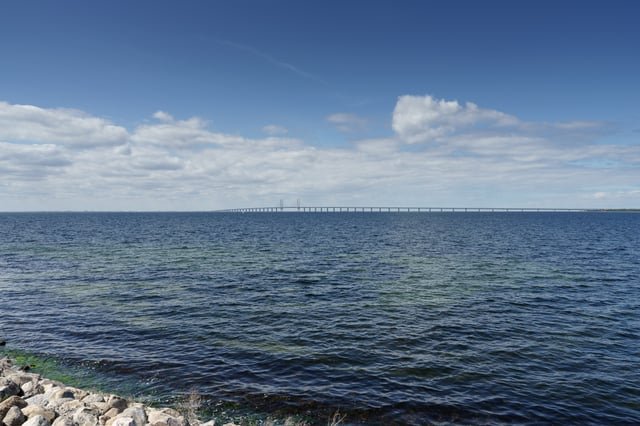
View from Klagshamn
The rail link across the Øresund is a collaborative effort between the Swedish Transport Administration and Danish railways. Passenger train services are managed by Skånetrafiken and the Danish transport agency under the Øresundståg brand, with Transdev and DSB serving as the current operators. A fleet of dual-voltage trains has been developed to connect the Copenhagen area with Malmö and southern Sweden, extending as far as Gothenburg and Kalmar. SJ operates X2000 trains across the bridge, providing connections to Gothenburg and Stockholm. Copenhagen Airport at Kastrup features its own railway station near the western bridgehead. Trains run at 20-minute intervals throughout the day, with hourly services during the night in both directions. Additional Øresundstrains are put into operation during rush hours. Furthermore, freight trains utilize the crossing as well, contributing to its multifunctional utility.
The rail section is double track 1,435 mm (4 ft 8 1⁄2 in) standard gauge and capable of speeds of up to 200 kilometres per hour (120 mph), slower in Denmark, especially in the tunnel section. There were challenges related to the difference in electrification and signalling between the Danish and Swedish railway networks. The solution chosen is to switch the electrical system from Swedish 15 kV, 16.7 Hz to Danish 25 kV, 50 Hz before the eastern bridgehead at Lernacken in Sweden. The line is signalled according to the standard Swedish system across the length of the bridge. On Peberholm the line switches to Danish signalling, which continues into the tunnel.
Trains run on the left in Sweden, and on the right in Denmark. Initially the switch was made at Malmö Central Station, a terminus at that time. After the 2010 inauguration of the Malmö City Tunnel connection, a flyover was built at Burlöv, north of Malmö, where the two southbound tracks cross over the northbound pair. The railway in Malmö thus uses the Danish standard.
Border checks
Both Sweden and Denmark are signatories to the Schengen Agreement, which removes border and passport controls between two participant countries. However, in January 2016, during the European migrant crisis, Sweden was granted a temporary exemption under the terms of the Schengen Agreement in order to mandate that all travellers across the bridge had photographic proof of identity. As such, travellers into Sweden from Denmark (but not the reverse) must show a valid passport or national ID card (citizens of EU/EEA countries) or passport and entry visa (if required) for nationals of other non-EU/EEA countries. The move marked a break with 60 years of passport-free travel between the Nordic countries.[21]
For the rail connection, these checks were initially enforced by legally requiring the train companies to verify the identities of travellers into Sweden, with a fine of SEK 50,000 as punishment for serving those without such identity documents.[22]This led to the enforcement of checks by private security guards at the rail station in Kastrup airport in Denmark – an unpopular move with passengers, due to the delays imposed[23]
From 2017, Sweden removed this requirement and instead replaced it with more extensive direct checks by the Swedish police on entry into the country. This now takes place on board the train at Hyllie station on trains arriving from Denmark, with the checks at Kastrup fully removed.[24]
The border controls were renewed on 12 May 2019, and will remain in place until 12 November 2019, with likely further temporary renewal after.[25]
Costs and benefits
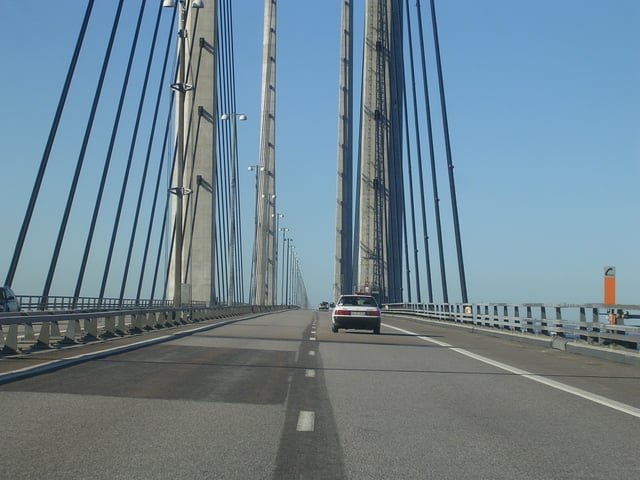
On the bridge
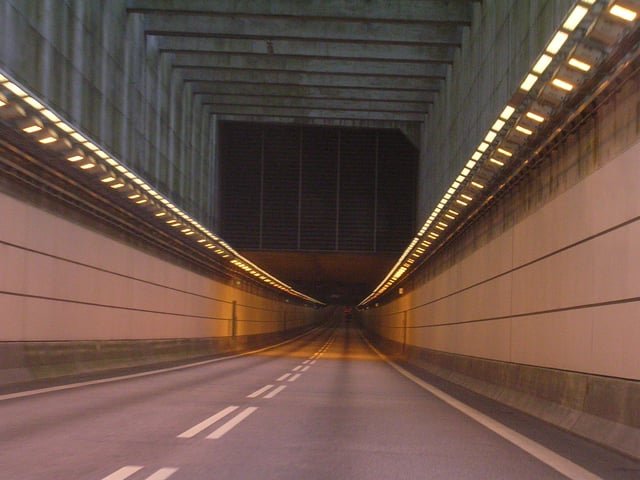
In the tunnel
The cost for the Øresund Connection, including motorway and railway connections on land, was DKK 30.1 billion (~€4.0 bn) according to the 2000 year price index, with the cost of the bridge expected in 2003 to be recouped by 2037.[26]In 2006, Sweden began work on the Malmö City Tunnel, a SEK 9.45 billion connection with the bridge that was completed in December 2010.
The connection will be entirely user-financed. The owner company is owned half by the Danish state and half by the Swedish state. This owner company has taken loans guaranteed by the governments to finance the connection and the user fees are its only income. After the increase in traffic, these fees are enough to pay the interest and begin repaying the loans, which is expected to take about 30 years.
Taxpayers have paid for neither the bridge nor the tunnel, but tax money has been used for the land connections. On the Danish side, the land connection has domestic benefits, mainly to connect the airport to the railway network. The Malmö City Tunnel has the benefit of connecting the southern part of the inner city to the rail network and allowing many more trains to and from Malmö.
According to The Öresund Committee, the bridge has made a national economic gain of DKK 57 billion, or SEK 78 billion SEK (~€8.41 billion) on both sides of the strait by increased commuting and lower commuting expense.[27]The gain is estimated to be SEK 6.5 billion per year but this could be increased to 7.7 billion by removing the three biggest obstacles to integration and mobility, the two largest being that non-EU nationals in Sweden are not allowed to work in Denmark and that many professional qualifications and merits are not mutually recognised.[28]
Cultural references
-
The Øresund Bridge gave its name to the Nordic noir television seriesThe Bridge, as the series was set in the region around the bridge.
-
When Malmöhosted the Eurovision Song Con in 2013, the Øresund Bridge was used as a symbol for the connection between Sweden and the rest of Europe.
-
It was the inspiration behind the 2014 song “Walk Me to the Bridge” by Manic Street Preachers from their albumFuturology.[29]
Environmental effects
The underwater parts of the bridge have become covered in marine organisms and act as an artificial reef.
See also
-
Fehmarn Belt Fixed Link
-
Great Belt Fixed Link
-
HH Tunnel, a proposed second Øresund fixed link connecting Helsingørand Helsingborg
-
List of bridge–tunnels
-
List of road-rail bridges
-
Old Little Belt Bridge (opened 1935) and New Little Belt Bridge (opened 1970)
-
Øresund Region
-
Øresundsmetro
